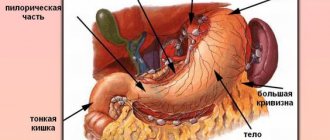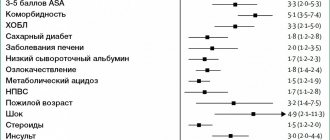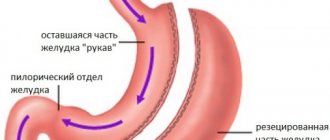Gastric acidity is a characteristic of the concentration of hydrochloric acid in gastric juice. This acid is produced by special parietal cells from the glands of the stomach. The main functions of hydrochloric acid are the digestion of protein foods, antibacterial action, stimulation of the pancreas, activation of digestive enzymes. And most importantly, hydrochloric acid contributes to the normal processing of food and its further movement into the duodenum.
Low acidity, as well as high acidity, absolutely equally causes the body a feeling of discomfort in the stomach area and leads to serious chronic diseases of the gastrointestinal tract.
Liquids with respect to their acidity are considered: neutral at pH = 7, acidic at pH < 7, alkaline at pH > 7.
The maximum theoretically possible acidity in the stomach is 0.86 pH.
The minimum theoretically possible acidity in the stomach is 8.3 pH. Normal acidity in the lumen of the body of the stomach on an empty stomach is 1.5–2.0 pH.
In addition, at different times of the day and in different parts of the stomach, acidity levels vary.
Causes leading to impaired stomach acidity
Increase acidity:
- poor quality nutrition, irregular food consumption, abuse of coffee, smoked meats, diet;
- there are many diseases that require long-term use of anti-inflammatory drugs;
- stressful situations;
- smoking, excessive nicotine intake;
- Helicobacter pylori infection.
Reduce acidity:
- Helicobacter pylori infection;
- eating disorder;
- bad habits;
- genetic disorders;
- diseases of the liver and pancreas;
- pathology of the endocrine system and metabolic processes.
As we can see, the reasons are largely similar. But in each individual person they will cause different manifestations of the disease, depending on the person’s initial health status, his lifestyle and diet, and the presence of concomitant pathology.
Increased acidity
“The condition when the concentration of acid in the stomach exceeds the norm is characterized as hyperacidity. Men have one and a half times more parietal cells than women - up to 1260 million cells. Thus, the stronger sex is more prone to diseases associated with high acidity,” says Zukhra Aliyeva.
The reasons why increased stomach acidity develops, the therapist notes, are as follows::
- unbalanced and unhealthy diet (fatty, fried and spicy foods, smoked foods, fast food, irregular meals, overeating, strict diet);
- taking medications that affect the gastric mucosa (non-steroidal anti-inflammatory drugs, hormonal agents, cytostatics);
- negative impact of chronic stress;
- bad habits (smoking, alcohol abuse);
- hormonal changes in the body (pregnancy, puberty, menopause);
- metabolic disorders.
All these reasons and factors, says the therapist, have an irritating effect on the gastric mucosa. In response to irritation, the parietal cells of the stomach begin to intensively produce more hydrochloric acid.
The stomach stopped. Why does it stop working and how to fix it? More details
“The habit of eating food too quickly also has a negative impact. An insufficiently moistened with saliva, poorly chewed food bolus that contains too large particles enters the stomach. To digest such food, the stomach walls are forced to produce more hydrochloric acid than during normal nutrition. Increased production of hydrochloric acid increases the acidity of gastric juice,” explains Aliyeva.
This problem is expressed as follows:
- epigastric pain; the pain syndrome is dull, aching in nature and most often occurs 1.5-2 hours after eating;
- heartburn (burning sensation immediately after eating);
- nausea up to vomiting, occurring 15-20 minutes after eating;
- belching with sour contents;
- often disturbing intestinal colic;
- deposition of a grayish-white coating on the root of the tongue;
- increased irritability;
- heaviness in the stomach - a feeling of fullness in the digestive organ even after a minor meal or snack;
- excess acid can also manifest itself as diarrhea or, conversely, constipation, bloating, and decreased appetite.
It is important to correctly assess risks. “The constant exposure of surrounding tissues to hydrochloric acid gradually destroys them. The mucous membrane becomes inflamed and erosions appear on it,” says Zukhra Aliyeva.
Among the common consequences of high acidity:
- gastritis
- ulcers and erosive-ulcerative lesions;
- gastrointestinal bleeding;
- non-ulcer functional dyspepsia syndrome;
- gastroduodenitis
“Self-medication and relief from symptoms can only worsen the course of the disease, since the pH must first be accurately established. To prevent the disease from worsening, it is important to seek medical help in a timely manner. Based on the test results and the patient’s current condition, the specialist will choose how to treat the stomach acid disorder,” says the therapist.
Typically, treatment involves taking enzymes, antisecretory drugs (in particular proton pump inhibitors), antacid drugs, gastroprotectors, symptomatic therapy (for example, pain relief) and following a special diet.
Proper nutrition is an important component of recommendations on how to cure high stomach acidity. Fatty and smoked foods, mushrooms of any kind, pickled and fresh vegetables, onions and garlic should be excluded from the diet. The menu is worked out by a gastroenterologist and adjusted during the treatment process.
Not sparing your belly. Any pathology begins with problems in the stomach Read more
What symptoms will help to suspect a violation of stomach acidity?
High acidity is characterized by: heartburn, pain “in the pit of the stomach”, in the right hypochondrium, the nature of the pain can be different (aching, paroxysmal), sour belching, burning in the throat and chest, white coating on the tongue. Later symptoms: constipation, intestinal colic.
Low acidity is characterized by: putrid odor, rotten egg belching, metallic taste, diarrhea and constipation, decreased intestinal motility, flatulence, the presence of undigested food residues in the feces. In addition, with low acidity, the absorption of vitamins and minerals and protein digestion are impaired. Which in turn is manifested by acne, brittle hair and nails, decreased hemoglobin, lethargy, decreased stamina, and the frequent occurrence of fungal and parasitic diseases.
However, it is impossible to judge only on the basis of the patient’s feelings about the presence of a violation of the level of acidity in the stomach. To make a correct diagnosis, a person must undergo an examination.
Symptoms of low acidity
After eating, many people may experience a feeling of heaviness, especially if food is consumed “on the go,” in a hurry, or poorly chewed. With normal stomach function, this sensation passes quite quickly, and you forget about it. If you regularly feel heaviness that does not go away for a long time, this is a reason to consult a gastroenterologist.
In addition to severity, you may be tormented by other symptoms indicating low acidity:
- Belching with a rotten odor;
- Constant bad breath, not related to oral hygiene;
- Problems with stool, most often constipation;
- Nausea and vomiting;
- The presence of undigested food particles in the stool;
- Pain in the stomach that occurs sharply with a cramping character;
- Bloating and increased gas formation;
- Lack of appetite.
If you ignore such manifestations or try to get rid of the symptoms on your own, serious consequences for your body are possible.
Methods for determining acidity
There are a number of methods for determining the acidity of gastric juice. Some of them are not very convenient, some are not very accurate. There are two main methods currently in use.
The first of them is the determination of acidity directly during FGDS. When a dye is introduced through a probe during a study and the acidity is judged by the color change. But this is only an indirect definition. But the “gold standard”, the most informative and physiological method is intragastric pH-metry. A probe is inserted into the stomach, which allows you to simultaneously determine the acidity in different areas of the stomach.
From all of the above, the following conclusions can be drawn.
If you are concerned about any of the above symptoms, then you need to take action to maintain and strengthen your health.
You need to contact a gastroenterologist, who, depending on your complaints and symptoms of the disease, will prescribe the necessary examination. And based on the results of the examination, you will receive specific recommendations on nutrition, lifestyle changes that you need, and receive medication prescriptions. After all, under-examination and self-medication can lead to irreparable loss of health. Remember this. We are waiting for you at our clinic.
Why is it dangerous?
Low acidity levels can lead to serious disturbances in the gastrointestinal tract. It is also a symptom of a number of complex diseases and pathologies, such as:
- Gastritis in the chronic phase;
- Endocrine diseases, including diabetes mellitus;
- Anemia;
- Infections caused by parasites;
- Oncology.
The sooner you contact a good gastroenterologist in Rostov, the sooner he will be able to determine the cause of low acidity and prescribe appropriate treatment. The medical office is attended by an experienced specialist who will help solve your problem. If there is insufficient information to make a diagnosis, you will be prescribed an additional examination: tests or ultrasound of the abdominal organs in Rostov-on-Don. Only if there is a complete picture of the disease, the doctor will select the treatment that is right for you, taking into account the characteristics of the body. Our goal is to solve the problem, not relieve you of symptoms. To make an appointment, use the convenient form or contacts of the medical center listed on the website. The hotline is available to you 24 hours a day: +7 (863) 333-20-11.
What is stomach acidity
The definition of what gastric juice acidity is as follows: this is the concentration of hydrochloric acid in its composition. This pH indicator is measured in units; accordingly, the study determines the pH of gastric juice.
How to check the stomach if certain problems appear and there is a suspicion of the development of gastritis? If a patient complains of pain and fermentation in the stomach, then initially a gastroenterologist suggests that he conduct an FGSD study, as well as an analysis of gastric juice . Such an examination makes it possible to determine the state of the gastric mucosa and what the acidity is.
Normal acidity is important for the digestion process. In order for food to be digested as needed, enzymes . The main such enzyme is pepsin , which is produced and functions correctly only in an acidic environment. But further, for the contents of the stomach to enter the intestines and be properly absorbed, neutralization of the acid is necessary.
That is why two zones of the stomach are defined - the body and fundus, in which acid is formed, and the antrum, in which its neutralization takes place. When examining gastric acid and its concentration in gastric juice, these points must be taken into account.
The work of all organs and systems in the body is interconnected. And therefore, any, even the most minor, disturbances in the processes that occur in the stomach lead to disruption of food digestion as a whole. As a result, symptoms of stomach problems appear
Hydrochloric acid is produced by the cells of the fundic glands, they are called parietal glands. Hydrochloric acid in the stomach is produced constantly and equally intensively by these cells. What acid is in the human stomach depends on these cells. If they gradually die off, acidity levels decrease; if their number increases, the person is bothered by symptoms of high acidity. Signs of increased or decreased acidity are also observed if the degree of acid neutralization in the antal region of the stomach changes.
If the number of these cells gradually decreases, then over time the fundic glands also atrophy. atrophic gastritis increases significantly . This condition is unsafe, since in patients with atrophic gastritis the risk of developing oncological processes in the stomach increases sharply. In order to take the necessary measures in a timely manner and prevent such a serious disease, a patient with atrophic gastritis should regularly visit a gastroenterologist.
After all, the patient very often perceives the first signs of stomach cancer as an exacerbation of gastritis or its seasonal manifestations.
General information
Statistics show that gastritis with low acidity accounts for approximately a quarter of all cases of gastritis with which patients consult doctors. If an inflammatory process of the gastric mucosa is discovered for the first time during fibrogastroduodenoscopy in a person, then, as a rule, he is diagnosed with “superficial gastritis with high acidity .”
And when the acute inflammatory process becomes chronic, then high acidity levels remain for a long time. But if chronic gastritis progresses over the years, then in approximately 60% of cases there is a decrease in acidity values. In this case, signs of low stomach acidity appear. That is why this condition is more typical for older people.






